Farewell, Bro: How Matt Fraction and David Aja's 'Hawkeye' changed Marvel Comics
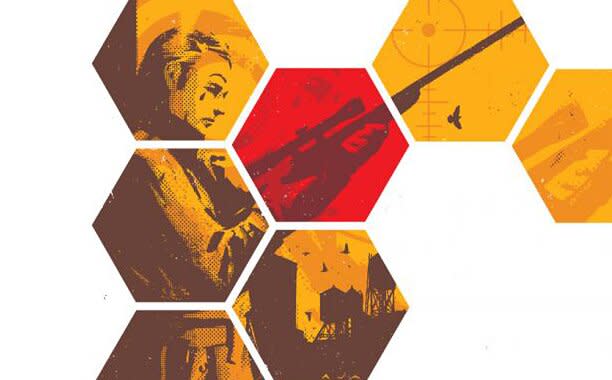
Marvel
Clint Barton, a.k.a. Hawkeye, became the greatest sharpshooter known to man. He then joined the Avengers. This is what he does when he’s not being an Avenger.
Those are the opening words of the first issue of Hawkeye, the acclaimed Marvel comic by Matt Fraction and David Aja, which is about to end its current run. After three years and 22 issues, we’ll be saying goodbye to Clint Barton, Kate Bishop, Lucky, and the Tracksuit Mafia as we know them—and while we’ll mourn losing Fraction’s poignant narrative and the masterful art of Aja and Annie Wu, the ending of Hawkeye is also something to be celebrated.
Case in point: This week will find us exploring an entirely new series about Clint Barton and Kate Bishop, as Marvel premieres the All-New Hawkeye, written by Jeff Lemire (DC’s Green Arrow) with art by the Eisner-winning Ramon Perez.
If someone had said three years ago that one of Marvel’s most popular books would be about a second-tier superhero, you might have laughed. You wouldn’t have been alone. First introduced in 1964’s Tales of Suspense #57, Hawkeye became notable as a criminal-turned-Avenger, joining up with the superhero squad following a wrong turn with Black Widow and Iron Man. He continued to fight alongside the team as a prominent member in multiple Avengers issues, his skills often accompanied by offbeat humor and his trademark ridiculous costume).
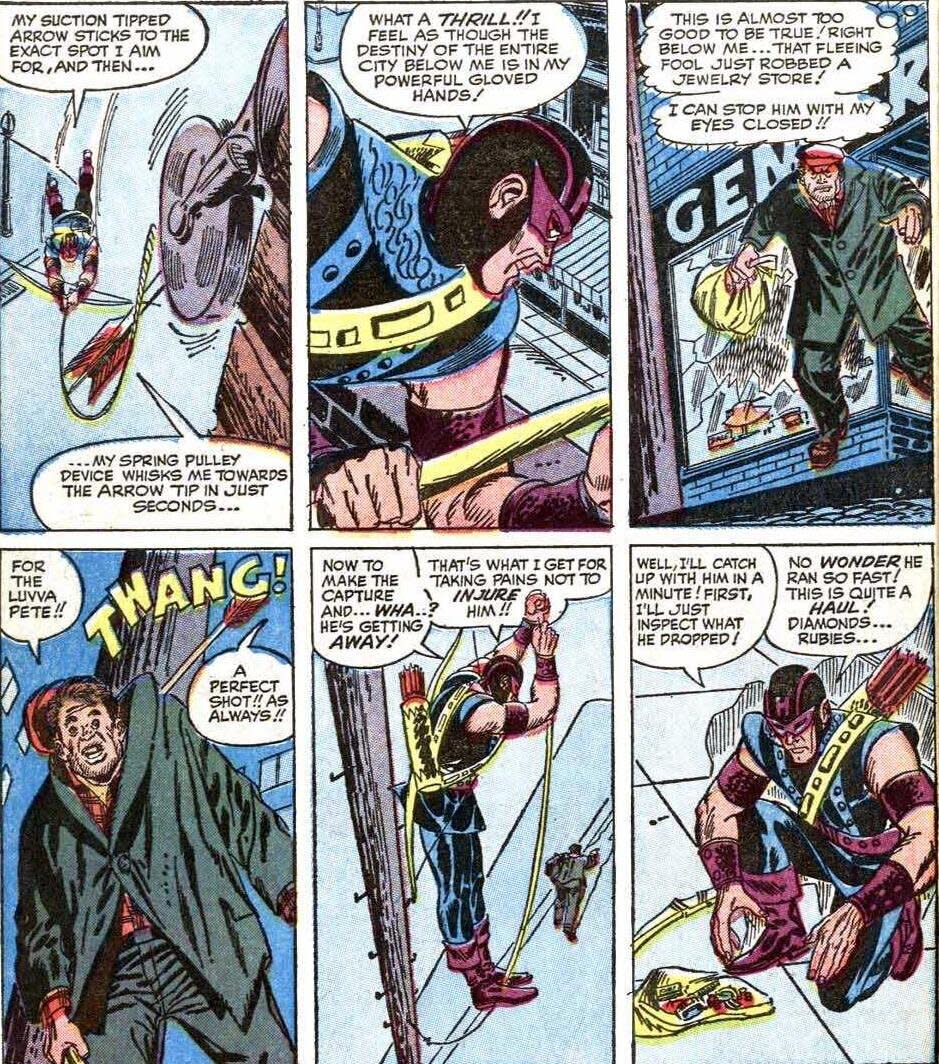
Marvel Comics
As a side character, Hawkeye was featured prominently in West Coast Avengers, and had short stints in Thunderbolts, Secret Academy, and Secret Avengers from 1992-2002. As a solo character, however, he was never an easy sell, unable to maintain an ongoing title for longer than a few months. Attempts to give the archer his own adventures (such as 2003’s short-lived Hawkeye Vol. 3) fell flat; in 2010, Jim McCann and David Lopez tried to get a series off the ground by launching Hawkeye & Mockingbird, which focused on the superhero’s escapades with his romantic partner, Bobbi Morse. Though the Hawkeye & Mockingbird series did allow for two additional books between 2010 and 2011 (Widowmaker and Hawkeye: Blindspot, respectively), the character never quite made a splash in the same way that other, more popular superheroes did.
That all changed in the wake of 2012’s The Avengers, when Fraction—then best known for his work on The Invincible Iron Man—pitched to Marvel an idea that seemed insane and brilliant all at once: Let’s show the world what Hawkeye does when he’s not being an Avenger. Let’s show the world what happens when he saves a stray dog and spills his coffee and oversleeps and misses his divorce anniversary. It was, pun intended, a shot in the dark…and to everyone’s surprise, it worked.
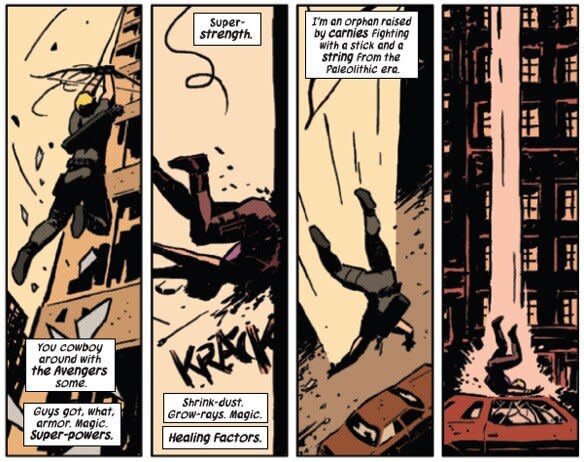
Marvel Comics
When we read comics, we connect to their characters because underneath their armor and special powers, they’re very real individuals battling very real, relatable issues. As a character without an otherworldly skill set, Hawkeye’s always been particularly approachable and empathetic. He became even more so in Fraction and Aja’s comic: Now we didn’t just understand Hawkeye because he was human, but also because we’ve also messed up a relationship, or said the wrong thing to a friend, or regretted something in our past. The book exploded, and in turn, Marvel’s sales skyrocketed, drastically changing the way its comics were recieved.
Hawkeye became a flagship for Marvel Now!, an initiative launched by the company in 2012 to coincide with a shifting of the Marvel universe following the events of Avengers vs. X-Men. But perhaps more importantly, the success of Hawkeye’s “everyman” plotline paved the way for some of the most popular books in the series, which currently includes solo titles such as Black Widow, Ms. Marvel and Storm.
Almost all of these character-specific adventures feature similar themes that trace back to the roots set down by Fraction and Aja’s book: they’re about superheroes, humanized. Black Widow is a story focused on a woman atoning for past sins, with an emphasis on how this affects her personal life outside of the Avengers. Ms. Marvel is not just a book about a girl living a double life; it’s an exploration of Kamala’s experiences growing up as Muslim teenager.
But Hawkeye also used its storytelling to push the limits of what a comic could do from a creative standpoint. It gave us an issue told entirely from a dog’s point of view, and an issue completely rooted in American Sign Language; unsurprisingly, these two stories remain the best and most acclaimed of its run. The comic also split apart its main players for a period of time that would have been long even without extensive breaks in publication. Yet because Clint and Kate were such well-developed and well-written characters, you didn’t necessarily feel like you were missing anything in the narrative.
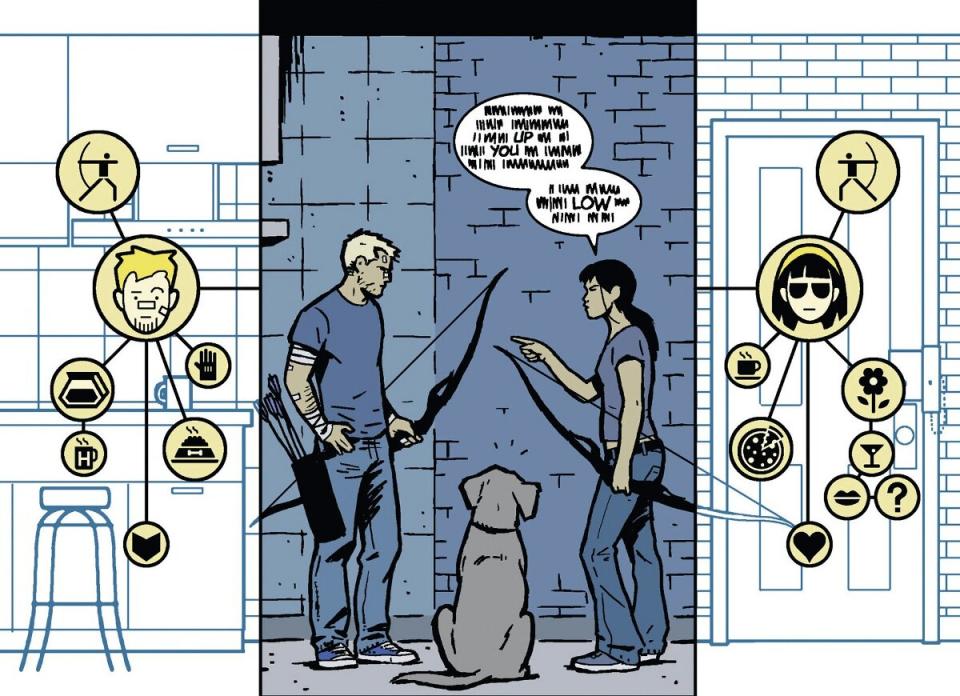
Marvel Comics
Then there was the collaboration between Fraction, Aja and Wu, as well as others who had a hand in making Hawkeye memorable: artists Javier Pulido, Steve Lieber, Jesse Hamm and Francesco Francavilla, colorist Matt Hollingsworth, and letterer Chris Eliopolous. Aja’s incredible ability to tell a story through tightly packed panels and specific colors gave a body to the soul that Fraction created, while Wu’s expressive drawings provided life for Kate Bishop’s trademark snark and spunk. Though the book brought about frequent creative changes, those changes didn’t remove you from the story. No matter who was taking the reins on the issue, each one seamlessly folded itself into a tale that continued to resonate, largely thanks to Fraction’s script.
It was from this book that my interest in comics segued from a casual hobby to an intense obsession, a need to read anything and everything from different creators and publishers. In a sense, it’s fair to say that Hawkeye was the gateway to a world in which I’d previously been hanging out on the fringes, wondering if anyone else would share my interest—let alone understand it.
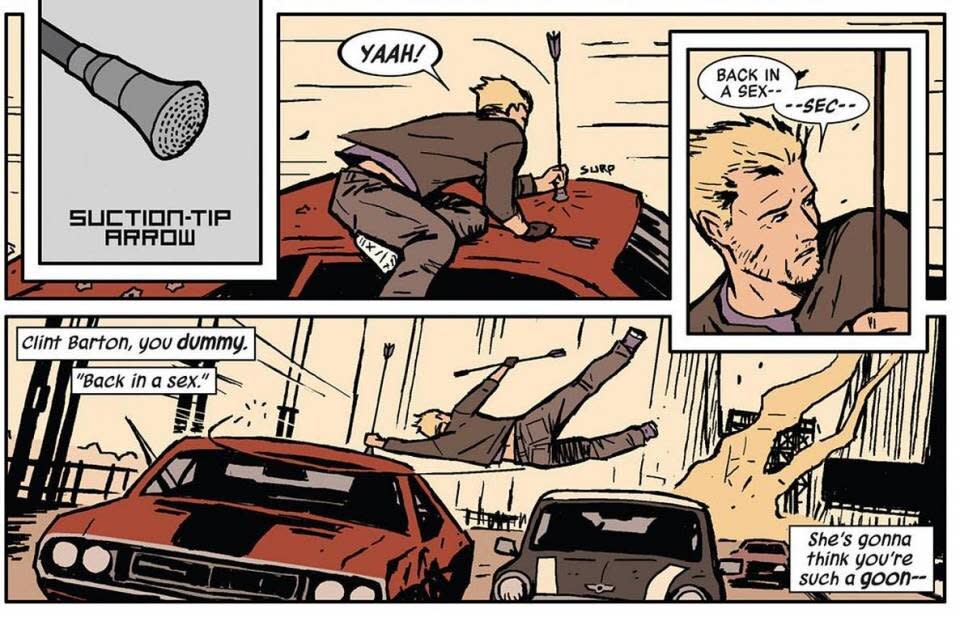
Marvel Comics
Maybe there’s something to be said about looking back at the success of a character who’s spent his whole life fighting against all odds, pushing through when no one expected him to. Like Lucky the Pizza Dog, this comic has been with me through some of the best moments in my life—and also through some of the worst. I owe a lot to its pages, which have made me laugh and have also made me cry, and I’m sad that we’re reaching the end of Clint Barton as he exists in this particular iteration. But I’ll forever be grateful for the impact Hawkeye had on comics—and on my own comic reading experiences—and I look forward to embracing this new chapter with an open mind and an invigorated heart.
All-New Hawkeye by Jeff Lemire and Ramon Perez goes on sale in comic shops March 4.

